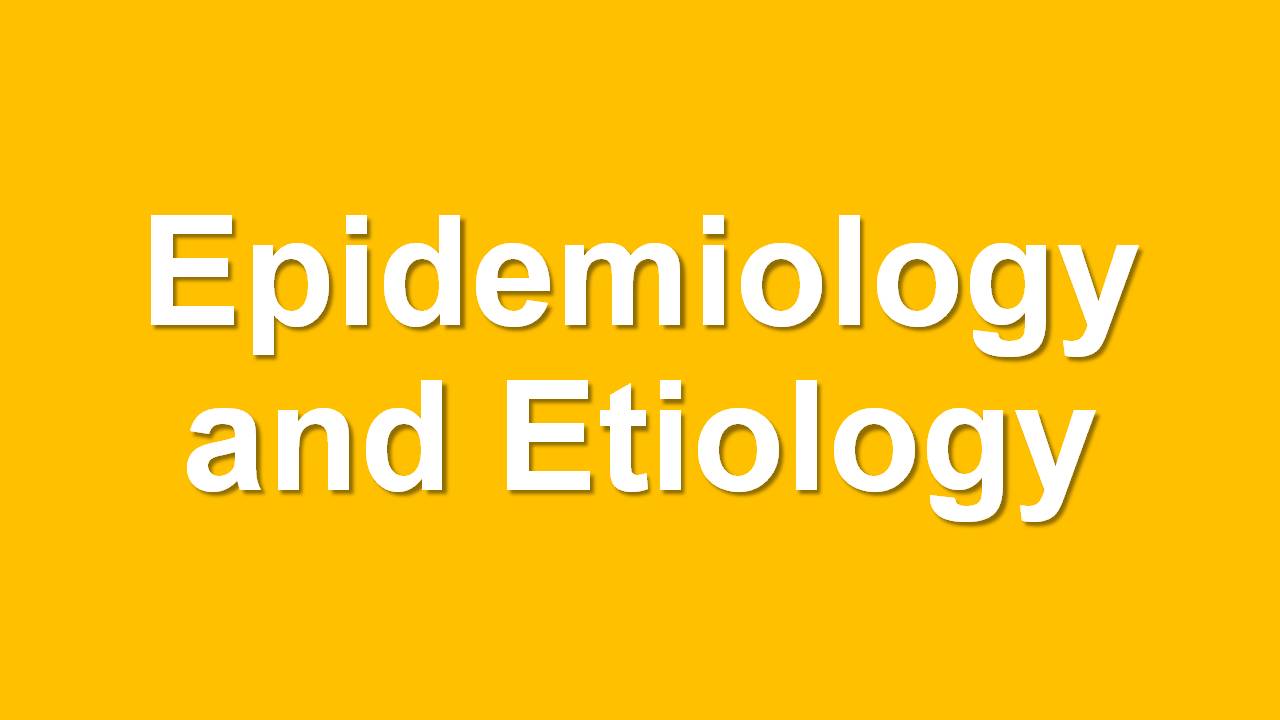Epidemiology and Etiology
Home > Clinical Concepts In Radiation Oncology > Patient Evaluation
Can we please get your advice on this one question?
As we begin our review of Clinical Concepts in Radiation Oncology, it is instructive to define the terms Epidemiology as well Etiology. The terms Epidemiology and Etiology are commonly used together. We will continue our review of patient evaluation with a consideration of Cancer Risk Factors as well as Prevalence and Incidence.
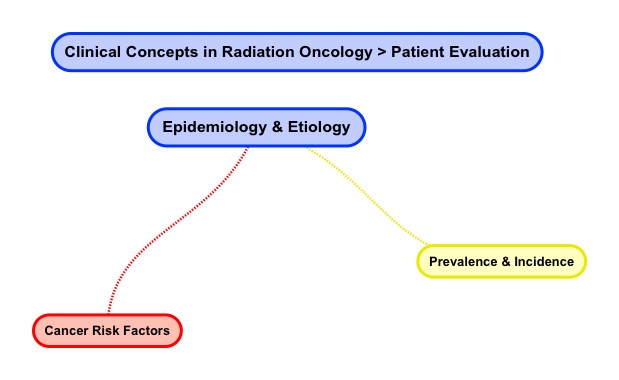
Epidemiology
Epidemiology
refers to a study of the progression and distribution of health status. Here
health status includes disease. Epidemiology is an ongoing process. http://www.who.int/topics/epidemiology/en/ The reasoning is that if the causes as well
as the distribution of disease are understood, then appropriate intervention
actions can be taken to improve the health of affected populations.
Etiology
Etiology is a term used to describe the causes as well as the remediation of health status. Here again, health status includes disease. http://www.nlm.nih.gov/medlineplus/ency/article/002356.htm The term etiology unlike epidemiology is also used outside the health care context to refer to the origins as well as effects of phenomena.
Take a look at the epidemiology / etiology diagram below which shows a relationship between: people, their environments, as well as the agents of disease.
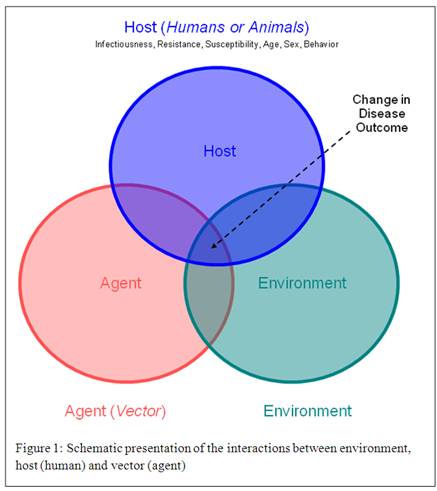
Prevalence and Incidence
We will begin by reviewing prevalence or the proportion of a population having a certain Cancer. We will continue by reviewing incidence; which is, the likelihood or risk that a part of a population will develop Cancer. Prevalence and incidence are reviewed here before Cancer risk factors since risk factors since depend on the disease site.
An important point to reflect on here is that the proportion of a population having a certain Cancer (prevalence) as well as the risk that a population will develop Cancer (incidence) depends on geographical location.
With
regard to prevalence, according to the American Cancer Society some
"1,660,290 new Cancer cases are
expected to be diagnosed in 2013, and in 2013 about 580,350 Americans are
projected to die of Cancer." http://www.cancer.org/research/cancerfactsstatistics/cancerfactsfigures2014/index
The top dozen Cancer types in the United Stare are:
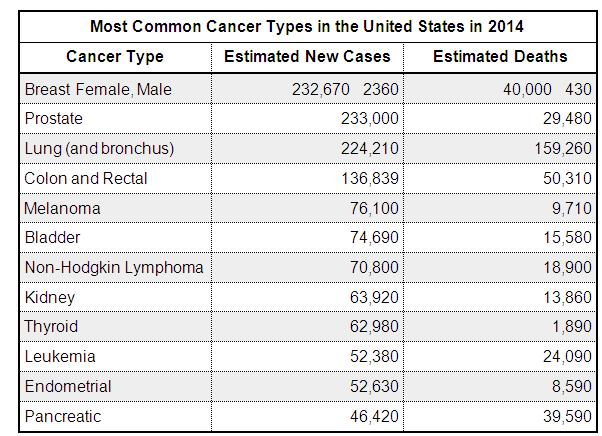
With
regard to incidence, plenty of statistics (facts & figures) are available
from the American Cancer Society by location (state), disease site, sex, race,
as well as age. Information on the probability
of age interval as well as geographic patterns are also available.
For
example, here is a visual graph of the incidence of Lung Cancer deaths by
geography.
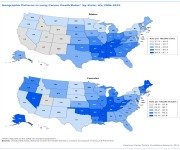
Cancer
Risk Factors
Cancer
risk factors can be divided into those factors which preventable and those
which are not-preventable. Cancer risk factors depend on the site of the
disease. By way of review, we will cover examples of some of the risk factors
for the top dozen Cancer sites.
Breast
Female: http://www.cdc.gov/cancer/breast/basic_info/risk_factors.htm
Risk
factors for breast cancer and generally divided into reproductive factors and
other factors. Some reproductive breast cancer factors are: early onset of
menarche ( the first menstrual cycle), late start of menopause, as well as
never giving birth. Two of the various
other risk factors include a family history of breast cancer as well as alcohol
consumption of more than a drink each day.
Prostate: http://www.cdc.gov/cancer/prostate/basic_info/risk_factors.htm
There
are various risk factors for prostate cancer. Let's consider three examples;
which are, age, family history, and race. As men age their risk of getting
prostate cancer rises. Second, men who
have a family history of prostate cancer as also at a higher risk for the disease. Third, some race / ethnicity groups (life
African Americans) have a higher risk of prostate cancer incidence.
Lung: http://www.cdc.gov/cancer/lung/basic_info/risk_factors.htm
There
are various lung cancer risk factors. It
is no surprise that the predominant lung cancer risk factors involve
respiration plus other factors. Smoking as well as the inhalation of other
chemical like radon & asbestos are strongly correlated to the likeliness of
getting lung cancer. Indeed, people who smoke are some 15 to 30 times more
likely to get lung cancer. One example of an "other" lung cancer risk
factor is radiation. People who have had radiation therapy to the thorax are at
a higher risk of acquiring lung cancer.
Colon and Rectal: http://www.cdc.gov/cancer/colorectal/basic_info/risk_factors.htm
There
are several colorectal cancer risk factors. Colorectal risk factors can be
roughly categorized as: age, family history, and lifestyle. With regard to age, some 90% of cases occur
in people over 50 years of age. Family history of colon and rectal disease is
also a risk factor. Additionally, there
are various lifestyle factors; for examples, obesity as well as tobacco use are
variables.
Melanoma: http://www.cancer.gov/cancertopics/wyntk/skin/page5
Melanoma
is a cancer originating in the integumentary (skin) system. Melanoma risk
factors involve various exposures or inflammations to skin as well as family
history of integumentary disease. Lifetime sun exposure as well as tanning are
examples of risk factors related melanoma.
Bladder: http://www.cancercenter.com/bladder-cancer/risk-factors/
Bladder
cancer risk factors can be categorized by gender, age, race, as well as
lifestyle. With respect to gender, men are more than three times more likely
than women of being afflicted with bladder cancer. With respect to age, most
cases of bladder cancer are diagnosed in people older than 55 years of age.
With respect to race, Caucasians are at least twice as likely to get bladder
cancer than other races (African America, Hispanic, as well as Asian).
Lifestyle risk factor examples include smoking and a low fluid intake.
Non-Hodgkin
Lymphoma: https://www.cancer.gov/types/lymphoma
Non-Hodgkin lymphoma is a cancer involving organs of the immune system like lymph tissue as well as the spleen. There are no well known causes of lymphoma. However, certain factors may increase the risk of a person getting Non-Hodgkin lymphoma. The disease tends to appear in people in the 60s and 70s. Non-Hodgkin Lymphoma also tends to be more prevalent in men than in women. Further, a patient history of having the epstein-barr (EBV) virus and / or an immune deficiency may increase the risk of a person getting Non-Hodgkin lymphoma.
Kidney: https://www.cancer.gov/types/kidney
Kidney
cancer risk factors include lifestyle as well as a family history of the
disease. With regard to lifestyle, factors like obesity, high blood pressure,
as well as smoking are correlated to a higher incidence of being afflicted with
kidney cancer. Patients who have had a family member with kidney disease are
also at slightly more risk of being afflicted.
Gender,
age, exposure to radiation, as well as family history are thyroid cancer risk
factors. Women are some three times more
likely than men of being afflicted with thyroid cancer. Thyroid cancer also
tends to manifest itself in people 25 to 75 years of age. Being exposed to head & neck radiation is
also correlated to a higher incidence of thyroid cancer. Further, a family or
genetic history involving the patient's medullary and / or endocrine system is
a thyroid cancer risk factor.
Leukemia: http://onclickrev.com/afu.php?zoneid=1220488
Leukemia
originates in the bone marrow and is a blood cancer. There are no well known
causes of Leukemia. However, certain factors may increase the risk of a person
getting Leukemia. A family history, lifestyle, as well as environment are NOT
correlated to the incidence of Leukemia.
What is known is that, children that have had multiple x-Ray imaging
studies are are a higher risk of developing Leukemia.
Endometrial: http://www.mskcc.org/cancer-care/adult/uterine-endometrial/risk-prevention-screening
Risk
factors for uterine cancer include age, lifestyle, as well as a family
history. The disease tends to appear in
women in the 50s and 60s. With regard to lifestyle, one example is a
correlation between obesity as well as the risk of getting uterine-endometrial
cancer. Diabetes as well as hypertension
are other factors. Also, a positive
family history of uterine-endometrial cancer is a risk factor.
Pancreatic cancer risk factors can be divided into lifestyle, race, as well as family history. With respect to lifestyle risk factor examples, smoking as well as a high cholesterol diet increase chances of being afflicted with pancreatic cancer. With respect to race, some populations like African Americas as well as peoples of Jewish origin are at a higher risk of being afflicted by pancreatic cancer. Also, a positive family history of pancreatic cancer is a risk factor.
Home > Clinical Concepts In Radiation Oncology > Patient Evaluation > Epidemiology and Etiology
FREE Infographic What successful people believe. What successful people do
Dictionary of Cancer Terms
Need help understanding a word? Here is an electronic resource that gives meaning to Cancer terms and their usage.

StrengthsFinder 2.0
